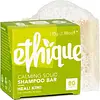What's inside
What's inside
 Key Ingredients
Key Ingredients

 Benefits
Benefits

 Concerns
Concerns

 Ingredients Side-by-side
Ingredients Side-by-side

Sodium Coco-Sulfate
CleansingSodium Cocoyl Isethionate
CleansingStearic Acid
CleansingTheobroma Cacao Seed Butter
EmollientDecyl Glucoside
CleansingWater
Skin ConditioningCocos Nucifera Oil
MaskingGlycerin
HumectantLactic Acid
BufferingCaprylic/Capric Triglyceride
MaskingAvena Sativa Kernel Meal
AbrasiveCitrus Aurantifolia Oil
CleansingBrassica Alcohol
EmollientSodium Isethionate
CleansingLimonene
PerfumingAzadirachta Indica Seed Oil
Skin ConditioningPongamia Glabra Seed Oil
Skin ConditioningBehentrimonium Methosulfate
Sodium Coco-Sulfate, Sodium Cocoyl Isethionate, Stearic Acid, Theobroma Cacao Seed Butter, Decyl Glucoside, Water, Cocos Nucifera Oil, Glycerin, Lactic Acid, Caprylic/Capric Triglyceride, Avena Sativa Kernel Meal, Citrus Aurantifolia Oil, Brassica Alcohol, Sodium Isethionate, Limonene, Azadirachta Indica Seed Oil, Pongamia Glabra Seed Oil, Behentrimonium Methosulfate
Water
Skin ConditioningSodium Laureth Sulfate
CleansingDecyl Glucoside
CleansingPEG-7 Glyceryl Cocoate
EmulsifyingCocamidopropyl Betaine
CleansingCitrus Aurantium Dulcis Oil
MaskingLavandula Angustifolia Oil
MaskingPelargonium Graveolens Flower Oil
MaskingCananga Odorata Flower Oil
MaskingAngelica Archangelica Root Oil
MaskingAngelica Archangelica Seed Oil
Skin ConditioningAvena Strigosa Seed Extract
Skin ConditioningLavandula Hybrida Oil
EmollientHelianthus Annuus Seed Oil
EmollientPanthenol
Skin ConditioningSodium Chloride
MaskingPolyquaternium-7
Glycerin
HumectantCoco-Glucoside
CleansingGlyceryl Oleate
EmollientSodium Benzoate
MaskingHydroxypropyl Guar Hydroxypropyltrimonium Chloride
Citric Acid
BufferingLecithin
EmollientPotassium Sorbate
PreservativeHydrogenated Palm Glycerides Citrate
EmollientAscorbyl Palmitate
AntioxidantTocopherol
AntioxidantParfum
MaskingLimonene
PerfumingLinalool
PerfumingWater, Sodium Laureth Sulfate, Decyl Glucoside, PEG-7 Glyceryl Cocoate, Cocamidopropyl Betaine, Citrus Aurantium Dulcis Oil, Lavandula Angustifolia Oil, Pelargonium Graveolens Flower Oil, Cananga Odorata Flower Oil, Angelica Archangelica Root Oil, Angelica Archangelica Seed Oil, Avena Strigosa Seed Extract, Lavandula Hybrida Oil, Helianthus Annuus Seed Oil, Panthenol, Sodium Chloride, Polyquaternium-7, Glycerin, Coco-Glucoside, Glyceryl Oleate, Sodium Benzoate, Hydroxypropyl Guar Hydroxypropyltrimonium Chloride, Citric Acid, Lecithin, Potassium Sorbate, Hydrogenated Palm Glycerides Citrate, Ascorbyl Palmitate, Tocopherol, Parfum, Limonene, Linalool
Ingredients Explained
These ingredients are found in both products.
Ingredients higher up in an ingredient list are typically present in a larger amount.
Decyl Glucoside is a glucose-based surfactant and emulsion stabilizer. It is created by reacting glucose with the fatty acids from plants.
Surfactants help clean the skin by trapping oil, sebum, and dirt to be washed away. As an emulsion stabilizer, it stabilizes the ingredients in a product by preventing them from separating.
This ingredient is biodegradable and non-toxic. This ingredient is commonly found in baby shampoos.
Decyl Glucoside is sometimes used to stabilize the UV filter Tinosorb.
Learn more about Decyl GlucosideGlycerin is already naturally found in your skin. It helps moisturize and protect your skin.
A study from 2016 found glycerin to be more effective as a humectant than AHAs and hyaluronic acid.
As a humectant, it helps the skin stay hydrated by pulling moisture to your skin. The low molecular weight of glycerin allows it to pull moisture into the deeper layers of your skin.
Hydrated skin improves your skin barrier; Your skin barrier helps protect against irritants and bacteria.
Glycerin has also been found to have antimicrobial and antiviral properties. Due to these properties, glycerin is often used in wound and burn treatments.
In cosmetics, glycerin is usually derived from plants such as soybean or palm. However, it can also be sourced from animals, such as tallow or animal fat.
This ingredient is organic, colorless, odorless, and non-toxic.
Glycerin is the name for this ingredient in American English. British English uses Glycerol/Glycerine.
Learn more about GlycerinLimonene is a fragrance that adds scent and taste to a formulation.
It's found in the peel oil of citrus fruits and other plants such as lavender and eucalyptus. The scent of limonene is generally described as "sweet citrus".
Limonene acts as an antioxidant, meaning it helps neutralize free radicals.
When exposed to air, oxidized limonene may sensitize the skin. Because of this, limonene is often avoided by people with sensitive skin.
The term 'fragrance' is not regulated in many countries. In many cases, it is up to the brand to define this term. For instance, many brands choose to label themselves as "fragrance-free" because they are not using synthetic fragrances. However, their products may still contain ingredients such as essential oils that are considered a fragrance.
Learn more about LimoneneWater. It's the most common cosmetic ingredient of all. You'll usually see it at the top of ingredient lists, meaning that it makes up the largest part of the product.
So why is it so popular? Water most often acts as a solvent - this means that it helps dissolve other ingredients into the formulation.
You'll also recognize water as that liquid we all need to stay alive. If you see this, drink a glass of water. Stay hydrated!
Learn more about Water